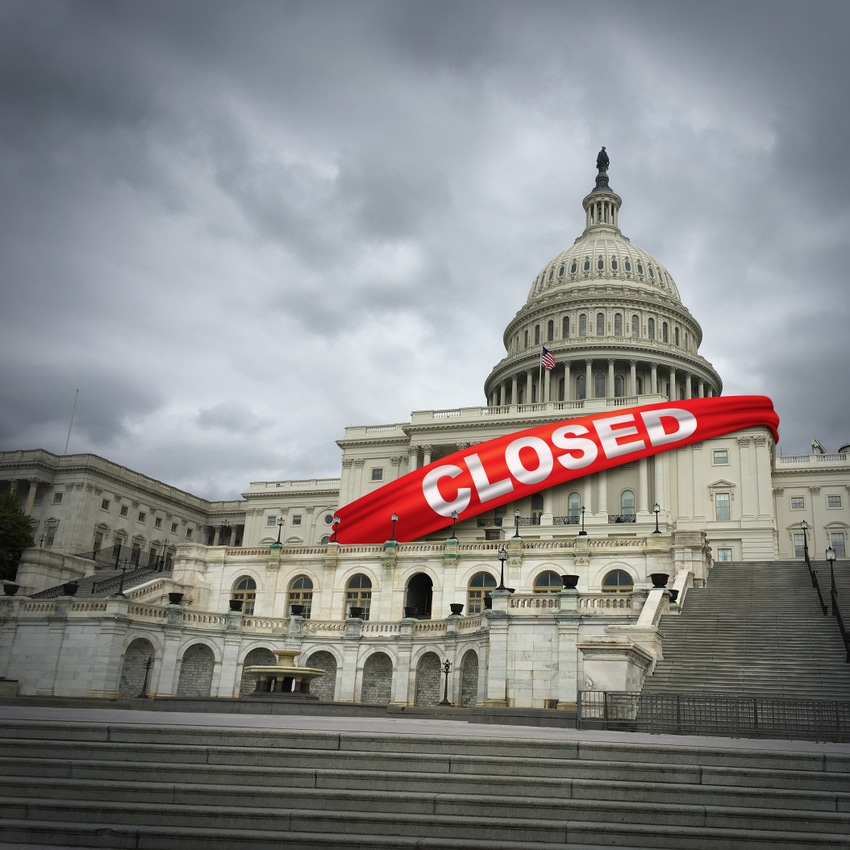
The partial shutdown of the U.S. government has entered its third week (as of Jan. 7). The shutdown officially began after Dec. 21, 2018. Through the holiday season, most of the discussion regarding the shutdown has been around the political division over the issues that initially lead to the shutdown. However, as the shutdown continues, more federal government services that will be suspended or reduced are being identified, and several of those could impact farm operators and the agriculture industry. Local USDA Farm Service Agency (FSA) offices remained open during the first week of the government shutdown through December 28, 2018; however, they have been closed since that date.
A majority of farm operators received the second half of the market facilitation payments (MFP) for federal tariff aide prior to the closure of local FSA offices on Dec. 28. Producers who had submitted MFP applications by Dec. 21, 2018 and had their 2018 production evidence processed, likely received their MFP payments, as long as there were no other issues related to issuing the payments. Producers who did not submit a MFP application by Dec. 21 or have not had their production evidence verified will need to wait until the government shutdown ends to receive eligible MFP payments. The deadline for MFP applications is Jan. 15, 2019, and the deadline to submit 2018 production evidence is May 1, 2019. No announcement has been made by USDA if the MFP deadline dates will be extended due to the government shutdown.
The closure of FSA offices also means that producers will not be able to take out Commodity Credit Corporation (CCC) loans until the government shutdown ends. The CCC loans are 9-month loans that are taken out on a producer’s 2018 grain production that is in storage. CCC loan applications that were made by Dec. 21 were likely processed by FSA offices, and the loan funds were released. Release of some CCC loan funds prior to the shutdown may have been delayed due to missing signatures or the FSA office needing other required information.
Many farm operators utilize CCC grain loans for short-term financing early in a given year to finish paying any accounts payable on their crop operation from the preceding year, or for payment of prepaid crop input costs for the current year. The CCC loans are usually at a reduced interest rate, compared to interest rates paid on traditional farm operating loans. Farmers that were counting on CCC loans for a portion of their 2019 financing may need to discuss other alternatives with their ag lender.
Many ag lenders utilize FSA direct and guaranteed loans as a financial tool for providing financing to farm operations. FSA loan guarantees have become extremely important in recent years during the current extended period of reduced farm income and low profit margins in most segments of farming. The loan guarantees reduce the risk to traditional ag lenders when they are providing financing to farm operations that have faced some financial challenges. The government shutdown will likely slow the FSA loan approval process, and if the shutdown continues, it could result in difficulties for some farm operators being able to finalize their 2019 farm operating loans on a timely basis.
The FSA direct loans are especially important to younger farmers and those with less than 10 years of experience, who may have difficulty getting financing through traditional lenders. The direct loans typically provide longer term loans at lower interest rates to producers for land purchases and other capital improvements. For farmers that are in this situation, the government shutdown could prevent them from getting the necessary financing through traditional ag lenders. The shutdown could also delay the FSA loan approval process to a point where producers might miss out on a purchase opportunity.
USDA has also announced that the monthly crop reports, as well as the supply and demand reports, scheduled to be released on January 11 will be delayed until further notice. The National Agricultural Statistics Service (NASS) January crop report is widely referred to, as it is usually very close to final national and state crop production and yield data for the previous growing season. The U.S. crop production data, along with updated crop production data for South America and other parts of the world, are included in the monthly World Agricultural Supply and Demand Estimates (WASDE) report, which was also scheduled to be released on January 11.
The WASDE report also includes updated grain usage and export estimates for U.S. grain supplies, as well as projections for farm-level grain prices for the current marketing year. These reports can be very useful to crop producers, livestock producers, processors, and others, as they are making marketing decisions, doing cash flow projections, and planning ahead for the coming year. If the government shutdown continues in the coming weeks, more USDA crop and livestock reports, as well as other data and reports, could be delayed.
The government shutdown will also likely slow the USDA implementation process for the new farm bill, which was signed into law in December 2018. It normally takes several weeks to get all the rules and regulations written for the revised farm programs and other farm bill provisions. FSA staff then need to be trained on the new farm programs before the sign-up process can begin. Farm operators will need to make a two-year farm program decision for all commodity crops for the 2019 and 2020 crop years once the farm program sign-up process begins at FSA offices.
As of this writing, there is no compromise federal budget solution on the horizon that would end the government shutdown. However, government services could be restored quickly, and FSA offices reopened soon, if an agreement is reached and a bill is passed by Congress, which is then signed by President Trump. The last Federal government shutdown was 2013 and lasted just over two weeks before a resolution was reached. The longest government shutdown in recent history occurred in 1995 and lasted 21 days. The current shutdown reached 17 days on Jan. 7.
Farm operators that were counting on utilizing CCC loans for short-term financing early in 2019 need to be patient until the government shutdown ends and local FSA offices are open again. If the shutdown continues, they may want to consult with their traditional ag lender for financing alternatives to replace the CCC loans. Ag lenders and farmers that were planning on utilizing direct and guaranteed FSA loans for financing need to be communicating with each other regarding potential short-term alternatives until the shutdown is halted. Producers who still need to apply for MFP payments will want to address this as soon as FSA offices reopen, as well as watch for any details from USDA regarding a potential extension of the MFP application deadline, which is currently Jan. 15.
About the Author(s)
You May Also Like






